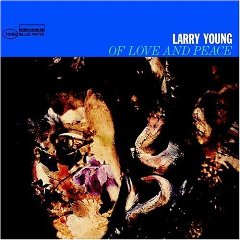Larry Young – Unity (1965)
Larry Young – Unity (1965)

1. "Zoltan" (Shaw) - 7:36
2. "Monk's Dream" (Monk) - 5:45
3. "If" (Henderson) - 6:42
4. "The Moontrane" (Shaw) - 7:18
5. "Softly, As in a Morning Sunrise" (Hammerstein, Romberg) - 6:20 play
6. "Beyond All Limits" (Shaw) - 6:00
Line-up / Musicians:
* Larry Young: organ
* Woody Shaw: trumpet
* Joe Henderson: saxophone
* Elvin Jones: drums
Larry Young (also known as Khalid Yasin (Abdul Aziz) (October 7, 1940 in Newark, New Jersey—March 30, 1978 in New York City) was an American jazz organist and occasional pianist. Young pioneered a modal approach to the Hammond B-3 (in contrast to Jimmy Smith's soul-jazz style). However, he did play soul-jazz also, among other styles.
From the year 1964 till 1975 it was hard to predict what style Larry Young would play next. During that eleven year period he played almost every conceivable style of modern jazz and fusion, as well as psychedelic and progressive rock. After starting as a bluesy hard bop organist, Larry moved on to the dry cerebral post bop of 1965's Unity, and in 1966 decided to go avant-garde with this album, Of Love and Peace.
Unity is an album by jazz organist Larry Young, released on the Blue Note label. While not free jazz, the album features innovative experimentation. The album is Young's second for Blue Note records, following on from Into Somethin'. Three of the six tracks were composed by Woody Shaw; "Zoltan", "The Moontrane", and "Beyond All Limits". "If" is a Joe Henderson composition, "Monk's Dream" is a Thelonious Monk composition, and "Softly, As in a Morning Sunrise" is a Hammerstein & Romberg composition.
Joe Henderson and Elvin Jones appear alongside Woody and Larry Young on this album, in many ways a breakthrough album for Woody. He was only 20 years old at the time, and three of his original tunes are featured on the album – Zoltan, The Moontrane and Beyond All Limits. Although Woody’s playing is not as fluid as it would be in a few years time, and his time feel is sometimes not spot on (especially on the up tempo numbers), overall his contribution to the album is very impressive. He is definitely beginning to find his own voice on the trumpet, and has clearly been checking out his pentatonic scales, as well as ways of playing ‘outside’ the harmony. A similar approach can be heard in the organ playing of Larry Young – like Woody, he was from Newark, New Jersey, and the two of them had played together for several years. Woody has attributed much of his harmonic knowledge to Larry Young in an interview with the now defunct ‘Musician’ magazine.
The first track is a composition by Woody entitled Zoltan and features a march theme by the Hungarian composer Zoltan Kodaly which utilises the pentatonic scale. The second theme is also composed entirely out of pentatonic scales. Woody uses the pentatonic of the II over a I chord, creating a lydian sound. The other compositions by Woody are The Moontrane, a tribute to John Coltrane, and Beyond All Limits, an incredibly fast swing number. Both are difficult tunes to play with lots of complicated chord changes and reflect the ambition of the young trumpet player. Woody’s best solo on the album, however, comes on the Joe Henderson tune If. This is a blues in F (concert), and the medium tempo and familiar structure means that Woody is free to explore his new method of using pentatonic scales to play ‘outside’ the standard chord changes. Woody’s sound on this album is still very similar to Freddie Hubbard, but he has now moved into new harmonic realms unexplored by the older trumpet player. –Nick Walters
Larry Young – amerykański muzyk jazzowy. Grał na instrumentach klawiszowych, zwłaszcza na organach Hammonda. Był pionierem stylu modalnego gry na tym instrumencie, w odróżnieniu od soulowej gry Jimmy'ego Smitha. Grał jednak również w innych stylach, w tym soul jazz. Od 1964 był związany z wytwórnią Blue Note Records. W tym czasie gra Younga zaczęła zdradzać wpływy Johna Coltrane'a. Odbył wiele sesji nagraniowych w trio z gitarzystą Grantem Greenem i perkusistą Elvinem Jonesem, niekiedy z dodatkowymi muzykami. Płyty pochodzące z tych sesji zwykle wskazywały Greena jako lidera, chociaż Into Somethin' z Samem Riversem na saksofonie była debiutem Younga w Bule Note jako lidera. Unity, najbardziej znany album Younga z tego okresu, został nagrany z Woodym Shawem, Joe Hendersonem i Elvinem Jonesem. Późniejsze albumy dla Blue Note to Contrasts, Of Love and Peace, Heaven On Earth, Mother Ship.
Od końca lat 60. Young uczestniczył w nagraniach fusion. M. in. można go usłyszeć na Bitches Brew Milesa Davisa oraz na Love Devotion Surrender Santany i McLaughlina. Był również członkiem zespołu Tony Williams Lifetime. Nagranie Younga z Jimim Hendriksem znalazło się na wydanej po śmierci Hendriksa płycie Nine to the Universe. Young zmarł na zapalenie płuc w wieku 37 lat.
Larry Young (also known as Khalid Yasin (Abdul Aziz) (October 7, 1940 in Newark, New Jersey—March 30, 1978 in New York City) was an American jazz organist and occasional pianist. Young pioneered a modal approach to the Hammond B-3 (in contrast to Jimmy Smith's soul-jazz style). However, he did play soul-jazz also, among other styles.
From the year 1964 till 1975 it was hard to predict what style Larry Young would play next. During that eleven year period he played almost every conceivable style of modern jazz and fusion, as well as psychedelic and progressive rock. After starting as a bluesy hard bop organist, Larry moved on to the dry cerebral post bop of 1965's Unity, and in 1966 decided to go avant-garde with this album, Of Love and Peace.
download (mp3 @320 kbs):
uploaded yandex 4shared mega solidfiles zalivalka cloudmailru filecloudio oboom
Last Updated (Sunday, 11 January 2015 12:35)








